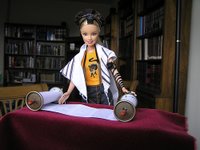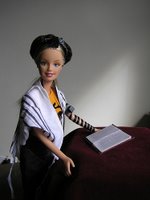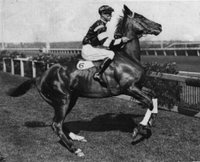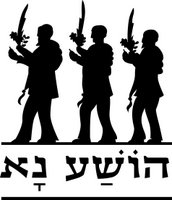As much as I love the Tefillin Barbie photos from my last post, I wonder if she has the same dilemma I face as a Jewish woman who follows the positive time bound mitzvot (TBM), such as wearing tallit and tefillin.
Traditionally, women are exempt from TBM. In many Orthodox and even some Conservative communities that women are basically forbidden to perform the TBM, along with davening and chanting Torah. For a great scholarly explanation on why this is not halachically correct, check out Danya Ruttenberg's post "I am postive that my time is bound by mitzvot"
But for me the dilemma is about feeling at times that I am an outcast in my own religion. Yes, I'm lucky to live in this day and age when there are many places where women who follow TBM are welcome. I belong to a very traditional Conservative synagogue which is completely egalitarian. I wouldn't have returned to the practice of Judaism without this community. And there are many such communities of varying denominations in the San Francisco Bay Area where I live.
Yet there are times I hear of different learning or davening opportunities that sound wonderful, but I know that I will not be welcomed. If it's a morning minyan, I will be an outcast as I start to put on my tefillin. If it's a Shabbat service, I will be an outcast as I put on my tallit. If it's a class, I will be placed in a separate section not close to the action, just because I am a woman.
Sometimes, I can just say "screw it," I have my community and I can concentrate on all the places I can go. Other times, this discrimination makes me sad.
One good piece of news is that there is now a listserve for women who follow TBM. If you're interested, you can click here to join.
Musings on life as I travel down a path of Jewish spiritual practice--listening to the ancient words speak to us in the world of today....
Tuesday, October 31, 2006
Friday, October 27, 2006
My kind of Barbie
Once again, the wonderful Danya Ruttenberg points me to the wonderful Jen Taylor Friedman, the soferot, who also is creating these Barbie role models.

Hagbah Barbie

Kriyat Torah Barbie

Daf Yomi Shiur Barbie
Thanks, Jen and Danya, we need these images.....

Hagbah Barbie

Kriyat Torah Barbie

Daf Yomi Shiur Barbie
Thanks, Jen and Danya, we need these images.....
The Road Taken
The quickest route driving from San Francisco to Los Angeles is to take Highway 5. It's also the ugliest route. For my trip today I decided to leave early and take 101 down--probably adding about an hour to my trip but spending the time amidst better scenery.
It was a good decision. When I take 5, I usually arrive in LA a bit beat, having completed a boring drive. I don't feel that way now. I think it's a combination of the mountain and ocean views and the less crowded roadways. I got creative with the route and think that I took an even longer way than I needed to--going off on Highway 1 when I should have stuck to 101. But that part of the drive proved to be the most empty of cars. So even though the speed limit was lower--anywhere from 40 to 55 depending on the section--I usually had the road to myself. And some of the ride was lined with eucalypltus trees, giving off great fragrance.
It was also nice to stop in Santa Barbara for lunch and not some highway rest stop. I walked along the beach for a bit, then down the pier before heading back to my car to finish the trip.
So if you're driving from San Francisco to Los Angeles, I would highly recommend leaving early and taking the time to take 101. It will make the trip more enjoyable and put you in a better mood when you arrive.
It was a good decision. When I take 5, I usually arrive in LA a bit beat, having completed a boring drive. I don't feel that way now. I think it's a combination of the mountain and ocean views and the less crowded roadways. I got creative with the route and think that I took an even longer way than I needed to--going off on Highway 1 when I should have stuck to 101. But that part of the drive proved to be the most empty of cars. So even though the speed limit was lower--anywhere from 40 to 55 depending on the section--I usually had the road to myself. And some of the ride was lined with eucalypltus trees, giving off great fragrance.
It was also nice to stop in Santa Barbara for lunch and not some highway rest stop. I walked along the beach for a bit, then down the pier before heading back to my car to finish the trip.
So if you're driving from San Francisco to Los Angeles, I would highly recommend leaving early and taking the time to take 101. It will make the trip more enjoyable and put you in a better mood when you arrive.
Tuesday, October 24, 2006
Mystery solved

More than 70 years after the fact, research scientists have confirmed what was always suspected -- the great New Zealand/Australian racehorse, Phar Lap, was indeed murdered, killed by the injections of a lethal dose of arsenic. The scientists used a bit of Phar Lap's preserved skin to do the anylysis.
From the article:
"Previous theories speculated the champion died of a stomach condition but many suspected foul play by US gangsters trying to avoid losses from Phar Lap's continued success."I knew I was justified in not wanting to go to the Tanfaran Shopping Center, the site of the racetrack just south of San Francisco where they did the evil deed (click here for a previous post explaining some of that).

I'm not sure why I'm so fascinated by Phar Lap. It probably comes from the same place as my admiration for Captain Cook (you might ask "what's that about," but I'll save it for another post). These are stories I was unaware of growing up in New York, but have entered my conciousness after being with Ken for all these years.
The Phar Lap story is one of spirit. This one-of-a-kind horse with, literally, a huge heart gave a small piece of joy to so many people hit hard by the Depression of the 1930s. How hard it must of been when this symbol of hope was murdered.
For the whole story with great photos, check out "A Tribute to Phar Lap."
Friday, October 20, 2006
Baruch Dayan HaEmet - Miriam Engelberg 1958 - 2006

Baruch Dayan HaEmet is a phrase many Jews say upon hearing bad news, oftimes on the loss of a life. I say that today upon hearing of the death of Miriam Engelberg--a bright spirit--who lost her battle with breast cancer this week.
Miriam was diagnosed with breast cancer in 2001, just months before my diagnosis. I met her in the Kaiser support group. She was the one who most often put smiles on our faces in a time that was filled with lots of tears. She was a talented cartoonist who chronicled her cancer experiences in a book called "Cancer Made Me a Shallower Person."
Her observations on the process were so right on. You might say, "well duh, she was going through it." Yes, but that doesn't mean that we don't go through our own fantasies and denials, pushing away the realities of the situation. Miriam was able to express what so many of us felt from a place of humor. It helped to laugh through the darkness. One favorite of mine dealt with trying to figure out what she did to get the disease--"it must have been all the cheese," she concluded.

To see more of her comics, and/or order her book, click on the cartoon.
Zichrona L'vracha
May her memory be a blessing
May her memory be a blessing
Thursday, October 19, 2006
Persimmon Season!

I went to Parkside Market today to pick up some fruit and veg. There, to my great delight, I saw the first persimmons of the season. For me, that's when I really know fall has arrived!
I've come to persimmons late in life. It's one of those produce items, such as avocados and artichokes, that I never saw growing up. Maybe it's a east coast/west coast thing; maybe it just wasn't in my parent's food sphere so they never bought them. Whatever, I am now a west coast gal and I love them all.
For the uninitiated, you can find two kinds of persimmons in the stores. The fuyus, pictured above, are small, squat, and firm. They can be easily sliced or just bite into one and eat it like you would an apple. The fuyus are the sweeter of the two varieties.
The hachiyas are bigger, oval-shaped, and should be eaten when soft. They are more tart than the fuyus, but still really good. They're a bit messy to eat when really ripe, but work really well as a sauce, eaten alone or over some ice cream--yummm.
Nutrition-wise, they are high in Vitamin A, with a nice amount of Vitamin C and fiber. For more information and some recipes, check out this page on our government's "5ADay" website. They've named persimmons "Fruit of the Month" I'm not sure whether they mean October or November, but as long as the seasons last--go for it.
Telecommunication made easy
 I'm old enough to remember a kitchen without a microwave oven, but I've always been able to reach anyone by phone. Granted, the first phone numbers I learned had letters in them--the phone number from most of my childhood was PY1-3567, which did become more commonly referred to as 791-3567. And yes, I had an area code--516. But this format remained the same as the years went by and my numbers changed.
I'm old enough to remember a kitchen without a microwave oven, but I've always been able to reach anyone by phone. Granted, the first phone numbers I learned had letters in them--the phone number from most of my childhood was PY1-3567, which did become more commonly referred to as 791-3567. And yes, I had an area code--516. But this format remained the same as the years went by and my numbers changed.Then numbers got longer. When you dialed out of your area code, you had to add a 1 before dialing the number. Of course, by then you weren't dialing you were pushing buttons. But all in all, not so radical a change.
Living with Ken means we make international calls more often--New Zealand, Australia, and the occasional England call. To make those calls, you have to add lots of numbers--country codes and city codes. Plus the Australians now have 8 digits in their numbers, not 7. Having to add all those numbers makes sense to me--after all, you'll connecting to a system half a world away. But yesterday, my phone world shrunk.
Ken is in New Zealand staying his parents while his sister takes some time off to go to a friend's wedding. He's alerted his clients that he will be away, but they still can get in touch with him by cell phone. The last time we were both in New Zealand using our respective phones and I needed to call him, I had to dial--actually, enter, we don't dial anymore-- lots of numbers from my cell to connect to his. Somehow I thought that's what his clients had to do. But last night when I wanted to see how his plane trip went, I just entered his normal 7-digit cell number. First I heard the normal US ring sound, then it switched to the more staccato New Zealand ring sound, and then Ken picked up. I made the call wondering if it would work, and was surprised when it did.
It's times like this I begin to realize the many years I've been around . . .
Tuesday, October 17, 2006
Healing Prayers

Yesterday I saw my friend Sylvie Braitman, a wonderfully talented singer and performer. Sylvie has been fighting breast cancer for the past 81/2 years, surviving against all odds. But modern medicine has run out of conventional treatments for her and as she says, " I am now on my own for a final confrontation, and it feels much calmer inside."
It was hard to see her, yet amazing to feel her quiet strength. She believes in the power of prayer, so anyone reading this, please put her in your prayers. Prayers of any flavor are appreciated, but if you follow Jewish healing practices, her name is Tziporah bat Hannah.
On Friday, November 10, 2006, Sylvie took her last breath. To read my post written after her funeral, click here.
Friday, October 13, 2006
Hoshana Raba

If there is any doubt about the ancient tribal connections of the rituals of Sukkot, the celebration of Hoshana Raba, the last day of Sukkot, should dispell those doubts. If you google Hoshana Raba, you'll find lots of explanations and justifications for the rituals that fall within the sphere of Jewish teachings and practice. For example, look here and here. And I'm glad the rituals from different times have found meanings in different generations--it enhances the spirit of the day.
Hoshana Raba encorporates the rituals of Sukkot week--see the post below for those details--but it's so much more. The service is one of the most, if not the most, complicated of the year. It's kind of a festival morning service, but has some weekday prayers, such as the prayers for thanks, something not said on Shabbat or festivals. The leader really needs to prepare and stay on top of things as we traverse here and there through the prayer book--"page 65....page 204....page 3...." We chant a full Hallel, complete with appropriate shakes and read the Torah--the description of the sacrifices performed at the Temple that week. (see Num 29:12 - 32)
The leader then dons a kittle--the white robe traditionally worn on Yom Kippur--to lead the next part of the service, the Musaf service, using the High Holiday melodies. (One woman remarked this morning--"wow--ceremony complete with costume changes!") Hoshana Raba marks the end of this series of Days of Judgement, one last reminder the keep that teshuvah, that turning and returning of the soul that was felt so deeply, with you as you continue through the year.
And then there's the processionals--not just once around, but 7 times. Each round having it's own theme - our relation to God, our relation to ourselves, our relation to others, our relation to the earth, and so on. This all culminates with the act of taking the willows from the lulav and beating them against the seats until all the leaves are gone. Why? No one really knows, although there are many explanations. Maybe it was a ritual to bring on rain; maybe because though we can make the leaves fall, the branch still exists; maybe it symbolizes the casting off of our sins. All these reasons and more are given. The fact is, no one really knows, and that's the beauty of it. We can connect deeply to our roots and bring our own feelings and interpretation to this powerful moment. For the moment is powerful, you can feel it in the room. We' all let collectively let loose in that moment of frenzy. We are are ready to fill for the next year.
I thank the ancient ones who brought this to us. I once again am able to tap into the stream of past, present, and future generations. As Rabbi Lew taught me, ritual makes the invisible visible. Whatever my doubts about my practice, my questions about my spiritual center--these rituals bring me home.
Wednesday, October 11, 2006
Tribal Rituals
 I have a deep connection to my Jewish roots. It's not just one tie, but appears in many levels. Although I am thoroughly American, I feel close to the Jewish Eastern European world of my grandparents. I look at the old photos and can place myself there--I see my face in theirs. As a student of Torah, I read the stories of the beginnings of my people, hear the teachings of our sages, and feel the link to them as I take their stories and interpretations as a base to find my own.
I have a deep connection to my Jewish roots. It's not just one tie, but appears in many levels. Although I am thoroughly American, I feel close to the Jewish Eastern European world of my grandparents. I look at the old photos and can place myself there--I see my face in theirs. As a student of Torah, I read the stories of the beginnings of my people, hear the teachings of our sages, and feel the link to them as I take their stories and interpretations as a base to find my own. During this holiday season, the connection reaches further back into very ancient times, before Abraham and Sarah--before even Abram and Sarai--back to the first tribal wonderings of my people. For while there are many rituals that I believe have their roots in that time, none are more obvious that the rituals surrounding the holiday of Sukkot.
During this holiday season, the connection reaches further back into very ancient times, before Abraham and Sarah--before even Abram and Sarai--back to the first tribal wonderings of my people. For while there are many rituals that I believe have their roots in that time, none are more obvious that the rituals surrounding the holiday of Sukkot.Each morning I take my lulav made up of a palm branch, 2 willow branches, and 3 myrtle branches; and my etrog, a citron, and join with others in the morning minyan shaking them in six directions - east, south, west, north, up, down. (For a good nuts and bolts explanation of the ritual, click here.) Before the end of the service, we all join in a processional, marching around the room chanting "Hoshana - Save Us" while the ark is opened and a Torah is taken out and held at the front.
The shaking of the lulav and etrog while reaching out to a direction and then bringing in towards my body evokes the same sort of viseral reaction I have when I wear my tefillin, but stronger. I literally feel the connection with my ancient ancestors--it vibrates within me. And marching with others reminds me of the need for community and the support that community brings. Our ancestors used these rituals to bind the community--a community they quite literally needed for survival. And for all our modernity--we need our community for survival as well.
Subscribe to:
Posts (Atom)